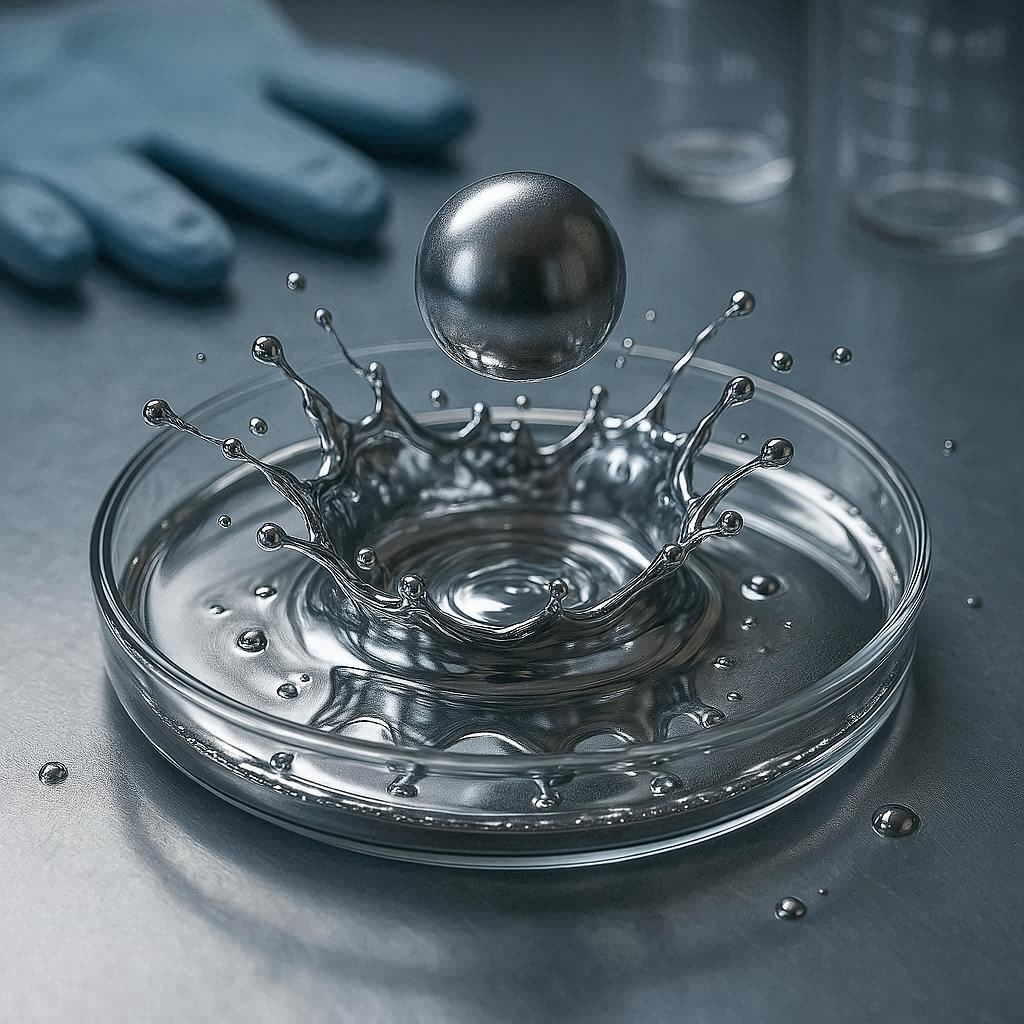Have you ever wondered what happens when you drop a metal ball into a pool of liquid metal? If you haven’t, you might be surprised at the fascinating science behind this simple yet intriguing experiment. Today, we’re going to dive into the phenomenon of dropping a metal ball into gallium, a lesser-known but incredibly interesting metal. By the end of this post, you’ll not only understand the science behind the splash but also appreciate the unique properties of gallium and its behavior under different conditions.
What is Gallium?
Before we delve into the experiment itself, it’s essential to understand what gallium is. Gallium is a chemical element with the symbol Ga and atomic number 31. It is a soft, silvery‑blue metal that is part of the boron group in the periodic table. At room temperature, gallium is solid, but it has a unique property: it melts at a temperature of just 29.76°C (85.56°F). This makes it one of the few metals that can melt in the human hand, given that the average human body temperature is around 37°C (98.6°F).
Gallium is also known for its non‑toxic and non‑reactive nature, which makes it safe to handle under normal conditions. It is commonly used in electronics, semiconductors, and even in some medical applications. However, it’s also a popular choice for science experiments due to its unique melting point and fluid dynamics when in its liquid state.
The Experiment: Dropping a Metal Ball into Gallium
So, what happens when you drop a metal ball into a pool of liquid gallium? To understand this, let’s break down the experiment step by step.
Step 1: Preparing the Setup
To perform this experiment, you’ll need a few simple materials:
- A small metal ball (preferably made of aluminum, copper, or another metal alloy)
- A container filled with liquid gallium (note: gallium can be purchased online or at scientific supply stores)
- A heat source (optional, but useful if the gallium is not already in its liquid state)
If your gallium is in its solid state, you’ll need to heat it slightly to melt it. This can be done using a heat gun, a hot water bath, or even by leaving it in a warm environment for a few minutes.
Step 2: Observing the Metal Ball
Before dropping the metal ball into the gallium, take a moment to observe its properties. Metal balls are typically solid, rigid, and have a high melting point compared to gallium. The metal ball will be denser than gallium, meaning it will sink if dropped into the liquid metal.
Step 3: Dropping the Metal Ball into Gallium
Now, carefully drop the metal ball into the container of liquid gallium. The moment the metal ball comes into contact with the gallium, several things happen:
- Initial Contact: The metal ball will make contact with the surface of the gallium, creating a splashing effect. This is similar to dropping a stone into water, but the behavior of gallium is quite different due to its unique properties.
- Sink or Float: Since the metal ball is denser than gallium, it will sink to the bottom of the container. However, unlike water, gallium has a very low viscosity, which means it flows more easily. This results in less resistance as the ball sinks.
- Surface Tension and Splashing: Gallium has a relatively high surface tension, which causes it to form a “skin” on its surface when exposed to air. When the metal ball is dropped, this surface tension is broken, leading to a splashing effect. The splash is less dramatic than with water, but it’s still noticeable.
- Cooling and Solidification: As the metal ball sinks into the gallium, it will begin to cool the liquid metal around it. If the metal ball is cooler than the melting point of gallium, it can cause the gallium to solidify around it. This can lead to interesting patterns and formations on the surface of the ball.
What Happens Next?
After dropping the metal ball into the gallium, you might be curious about what happens next. Let’s explore a few possibilities:
1. Dissolution of the Metal Ball
If the metal ball is made of a material that can react with gallium, such as aluminum, it might start to dissolve over time. Gallium is known to form alloys with other metals, and when it comes into contact with aluminum, it can create a eutectic alloy that has a lower melting point than either metal alone. This can lead to the metal ball gradually disintegrating as it reacts with the gallium.
2. Encapsulation of the Metal Ball
If the metal ball does not react with gallium, it might simply become encapsulated in a layer of solid gallium. As the gallium cools, it will solidify around the ball, creating a metallic shell. This can be an interesting way to observe the cooling and solidification process of gallium.
3. Splashing and Ripples
As the metal ball sinks into the gallium, it will create ripples and waves on the surface. These ripples can be observed and studied to understand more about the fluid dynamics of liquid metals.
The Science Behind the Splash
Now that we’ve explored what happens during the experiment, let’s delve deeper into the science behind the splash.
1. Fluid Dynamics
When you drop a metal ball into gallium, the movement of the liquid metal is governed by the principles of fluid dynamics. The viscosity of gallium, which is slightly higher than that of water, plays a significant role in how the metal flows and splashes. The less viscous the fluid, the more easily it flows, which is why gallium, with its low viscosity, flows relatively smoothly around the sinking metal ball.
2. Surface Tension
Surface tension is another important factor in this experiment. Surface tension is the elastic tendency of a fluid surface to minimize its area. In the case of gallium, the surface tension causes it to behave in a way that’s similar to water, but with some notable differences. When the metal ball is dropped, it breaks the surface tension of the gallium, creating a splash. The strength of the surface tension will determine the size and shape of the splash.
3. Heat Transfer
As the metal ball sinks into the gallium, heat transfer occurs between the ball and the surrounding liquid metal. If the metal ball is cooler than the gallium, it will absorb heat from the gallium, causing the gallium to solidify around it. This process can be slowed down or sped up depending on the temperature of the metal ball and the gallium.
4. Alloy Formation
If the metal ball is made of a material that can form an alloy with gallium, such as aluminum, the two metals will start to react. This reaction can lead to the formation of a new alloy with properties different from the original metals. For example, aluminum and gallium can form an alloy that has a lower melting point than either metal alone, allowing it to remain liquid at room temperature.
Why is This Experiment Interesting?
This experiment might seem simple, but it reveals a wealth of information about the properties of gallium and the behavior of metals in general. Here are a few reasons why this experiment is so interesting:
1. Unexpected Properties
Gallium has some unexpected properties that make it ideal for science experiments. Its low melting point and ability to form alloys with other metals make it unique among elements. By studying how gallium interacts with other metals, we can gain insights into the chemical and physical properties of gallium.
2. Fluid Dynamics in Liquid Metals
Studying the movement of liquid metals like gallium can provide valuable insights into the field of fluid dynamics. By observing how the gallium flows around the sinking metal ball, we can learn more about the behavior of viscous fluids and how they respond to external forces.
3. Alloy Formation
The process of alloy formation is a fundamental concept in materials science. By observing how gallium reacts with other metals, we can gain a better understanding of how alloys are formed and how they behave under different conditions.
4. Real-World Applications
Understanding the properties of gallium and its behavior in experiments like this can have real-world applications. For example, gallium is used in semiconductors, thermometers, and other electronic devices. By studying its behavior, we can improve the way it is used in these applications.
Safety Tips for Handling Gallium
Before you try this experiment at home, it’s important to take a few safety precautions to ensure you handle gallium safely.
1. Use Protective Gear
When handling gallium, it’s important to wear protective gear, such as gloves and eye protection. While gallium is non‑toxic, it can still cause skin irritation in some individuals.
2. Keep It Away from Children
Gallium is a metal that can be hazardous if mishandled. Keep it away from children and pets, and ensure that it’s handled in a controlled environment.
3. Avoid Ingestion
While gallium is non‑toxic, it should not be ingested. Ingesting gallium can cause digestive discomfort and other health issues.
4. Handle with Care
Gallium can be fragile when in its solid state, and it can break or shatter if dropped or handled roughly. Handle it with care to avoid accidents.
5. Clean Up Spills Immediately
If gallium spills, clean it up immediately. Gallium can leave stains on surfaces and can be difficult to clean once it solidifies.
Conclusion: The Science of Splash
Dropping a metal ball into gallium might seem like a simple experiment, but it reveals a wealth of information about the properties of gallium and the behavior of metals in general. By observing how the metal ball interacts with the gallium, we can gain insights into fluid dynamics, surface tension, heat transfer, and alloy formation. This experiment is not only fascinating to watch but also provides a unique opportunity to learn about the science behind the splash.
So next time you’re looking for a fun and educational science experiment, consider giving this one a try. Who knows, you might just uncover some of the secrets that make gallium one of the most interesting metals in the periodic table!



